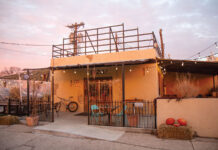
When The Gin Joint opened in 2010, there was little of national note in Charleston’s cocktail scene. Debuting the same year as famed Charleston chef Sean Brock’s Husk restaurant, The Gin Joint helped jump-start a cocktail renaissance that was already in full swing in major cities across the country. By 2012, bars like Proof and The Ordinary opened and a movement toward better drinking began to blossom alongside the ever-growing food scene.
A native of North Carolina, James Bolt had a dream of being in the food world since age 10, confirmed by his first job as a teen in a fine dining restaurant. Graduating from none other than the CIA (The Culinary Institute of America in Hyde Park, NY) in 2013, he actually worked under Brock at his upscale McCrady’s restaurant in Charleston. During that time, Bolt knew he wanted to move to Charleston.
Once in Charleston, Bolt started working at The Gin Joint, making the eventual leap from beverage director to bar owner in 2017. Though the sole proprietor of the bar, he still bartends, engaging with guests, crafting some of the city’s most creative cocktails with an impeccable sense of culinary balance.
In his own words, James talks about how he decides what spirits to stock behind his bar, how he educates customers and what is exciting him now in small-batch spirits.
Tell us a bit about your background.
I grew up in Highlands, a small town in North Carolina. It’s located about an hour and a half outside of Asheville. I started working in a local fine dining restaurant when I was sixteen and knew I wanted to pursue a career in the culinary field.
After high school I moved to Hyde Park, NY, to attend The Culinary Institute of America. When I graduated, I moved to Charleston to work at The Gin Joint. I had traveled a decent amount both inside and outside of the country, but knew that I wanted to move back south. I decided that Charleston was the place to be with how great the culinary scene was … it seemed to be ever-growing.
What led you to bartending?
The culinary expression in certain cocktail bars I frequented while in New York drew me in to bartending. It was a different way to express my creativity than cooking. But bartending still offered the ability to create something with my hands.
Once I started bartending, it allowed me to have a whole new thought process on how to merge and create flavors together. All the types of liquor, wine and beer that brought their own unique flavors to creating a cocktail completely drew me in. It allowed me to take my cooking background and combine it with something new in order to build unique and interesting cocktails for every bar guest.
How does living in Charleston
influence your bar style?
Living in Charleston has a lot of influences when I am creating a new seasonal menu. I look to all our local farmers for inspiration. There are so many fresh produce options that can grow in the Charleston area. For instance, there is a local farm that is growing turmeric and ginger for the consumer. Combine all the produce and great local distilleries in the area and it’s easy to create equally-as-great cocktails.
Charleston has an immense culinary and drinking culture that locals and tourists alike help create. Everyone knows Charleston is a culinary mecca, and they won’t settle for less. This makes all the bars, restaurants and distilleries push for a perfect product. All of these things combined influence me while creating the perfect cocktail and also just the perfect overall experience at The Gin Joint.
What is your philosophy in deciding what brands to stock behind your bar?
The thing I look most for in deciding what to stock and invest in is the quality of the product. If the time and effort has been taken in creating the best product, then that makes all the difference to me. You can really tell from tasting a spirit and talking with the people who produce it how much time and care they put into their products.
I also look for versatility in a product, the product tasting great on its own but also making a cocktail even better. I like having a nice variety of spirits to offer our customers. But carefully choosing the right ones can be difficult with how many amazing products there are. We only have so much shelf space to fill!
How do you and your team educate
customers on new and quality spirits?
My bar staff are trained on all the new spirits that we pick up. This helps ensure that when asked any questions about a specific spirit or ingredient, they can accurately describe it to a guest. It is important for us to explain each detail of an ingredient to customers so they can understand the flavors.
If the products we pick up are made with care, we want to be sure we are selling them with care. We also offer every single spirit we carry by a smaller half pour so guests can experience and explore the same products we fall in love with every day.
What advice would you give to distilleries looking to be represented in quality bars?
Let the quality of your product speak for itself. Don’t cut corners to speed up making something. Take the time and effort to create something with unique qualities that stand out. I look for those distillers that are pushing boundaries in order to create a quality product that is new and exciting to the people behind the bar and also the consumers. When the people who make the product are proud of it, it’s easy for us to put it on the shelf.
What are some microdistillers/small-batch brands that are exciting you right now?
There are a lot of great new micro and small-batch spirits that have piqued my interest lately. High Wire in Charleston is making a Southern Amaro that is packed with locally sourced and foraged ingredients. They’re using black tea from Charleston Tea Plantation, the only tea plantation in North America. They also have been working closely with Sean Brock and a few farmers to bring back Jimmy Red corn, an almost extinct type of corn that was known back in the day for making moonshine. They have used this corn to make a Jimmy Red Straight Bourbon Whiskey at 102 proof that is a gem to sip on.
Another local distillery is Charleston Distilling that is producing great gin with an awesome botanical build. The flavors make it perfect for cocktails. They are also producing a 94-proof wheated bourbon called Vesey’s that, much like the Jimmy Red Corn Whiskey, is perfect for sipping on. While these two local staples are creating awesome products, there are so many more outside the Charleston area that surprise me all the time.
Besides your bar, what do you think are some “can’t miss” food and drink spots when people are visiting your city?
There are so many awesome “can’t miss” spots in Charleston. Honestly, it’s hard to find bad food and drink here. There are so many great drink spots in the city alone. I frequent Proof for their extensive classics menu, the Bar at Husk for their spirits selection and their Dragoon Punch, Bar Mash for whiskey and, of course, a French Quarter staple, the Griffon, for a cold beer after work.
As for food, my favorite spots span the metro area. I will always try to grab a seat at 167 Raw for an awesome raw bar, Xiao Bao Biscuit for flavor-packed Asian dishes, Leon’s Fine Poultry and Oysters, for, well, chicken and oysters, Wild Olive for my girlfriend’s favorite Italian dishes and Rodney Scott’s for the best whole hog BBQ in the state. n








